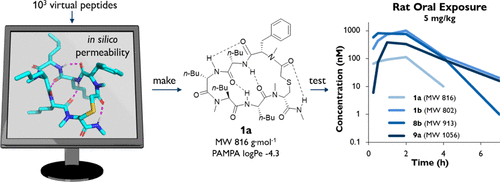当前位置:
X-MOL 学术
›
J. Med. Chem.
›
论文详情
Our official English website, www.x-mol.net, welcomes your feedback! (Note: you will need to create a separate account there.)
Design of Thioether Cyclic Peptide Scaffolds with Passive Permeability and Oral Exposure
Journal of Medicinal Chemistry ( IF 7.3 ) Pub Date : 2021-02-25 , DOI: 10.1021/acs.jmedchem.0c01505 Andrei A. Golosov 1 , Alec N. Flyer 1 , Jakal Amin 1 , Charles Babu 1 , Christian Gampe 1 , Jingzhou Li 1 , Eugene Liu 1 , Katsumasa Nakajima 1 , David Nettleton 1 , Tajesh J. Patel 1 , Patrick C. Reid 2 , Lihua Yang 1 , Lauren G. Monovich 1
Journal of Medicinal Chemistry ( IF 7.3 ) Pub Date : 2021-02-25 , DOI: 10.1021/acs.jmedchem.0c01505 Andrei A. Golosov 1 , Alec N. Flyer 1 , Jakal Amin 1 , Charles Babu 1 , Christian Gampe 1 , Jingzhou Li 1 , Eugene Liu 1 , Katsumasa Nakajima 1 , David Nettleton 1 , Tajesh J. Patel 1 , Patrick C. Reid 2 , Lihua Yang 1 , Lauren G. Monovich 1
Affiliation

|
Advances in the design of permeable peptides and in the synthesis of large arrays of macrocyclic peptides with diverse amino acids have evolved on parallel but independent tracks. Less precedent combines their respective attributes, thereby limiting the potential to identify permeable peptide ligands for key targets. Herein, we present novel 6-, 7-, and 8-mer cyclic peptides (MW 774–1076 g·mol–1) with passive permeability and oral exposure that feature the amino acids and thioether ring-closing common to large array formats, including DNA- and RNA-templated synthesis. Each oral peptide herein, selected from virtual libraries of partially N-methylated peptides using in silico methods, reflects the subset consistent with low energy conformations, low desolvation penalties, and passive permeability. We envision that, by retaining the backbone N-methylation pattern and consequent bias toward permeability, one can generate large peptide arrays with sufficient side chain diversity to identify permeability-biased ligands to a variety of protein targets.
中文翻译:

具有被动渗透性和口服暴露性的硫醚环状肽支架的设计
渗透性肽的设计和具有不同氨基酸的大环肽的大阵列合成的进展已在平行但独立的轨道上发展。较少的先例结合了它们各自的属性,从而限制了识别关键靶标的可渗透肽配体的潜力。在这里,我们介绍了具有被动渗透性和口服暴露性的新型6、7和8聚环肽(MW 774–1076 g·mol –1),其特征是大阵列形式所共有的氨基酸和硫醚闭环,包括以DNA和RNA为模板的合成。本文中的每个口服肽均使用计算机技术从部分N-甲基化肽的虚拟文库中选择这些方法反映了与低能构象,低去溶剂化罚分和被动渗透率一致的子集。我们设想,通过保留主链的N-甲基化模式并因此对通透性产生偏见,人们可以产生具有足够侧链多样性的大型肽阵列,以鉴定通透性偏向于各种蛋白质靶标的配体。
更新日期:2021-03-11
中文翻译:

具有被动渗透性和口服暴露性的硫醚环状肽支架的设计
渗透性肽的设计和具有不同氨基酸的大环肽的大阵列合成的进展已在平行但独立的轨道上发展。较少的先例结合了它们各自的属性,从而限制了识别关键靶标的可渗透肽配体的潜力。在这里,我们介绍了具有被动渗透性和口服暴露性的新型6、7和8聚环肽(MW 774–1076 g·mol –1),其特征是大阵列形式所共有的氨基酸和硫醚闭环,包括以DNA和RNA为模板的合成。本文中的每个口服肽均使用计算机技术从部分N-甲基化肽的虚拟文库中选择这些方法反映了与低能构象,低去溶剂化罚分和被动渗透率一致的子集。我们设想,通过保留主链的N-甲基化模式并因此对通透性产生偏见,人们可以产生具有足够侧链多样性的大型肽阵列,以鉴定通透性偏向于各种蛋白质靶标的配体。



























 京公网安备 11010802027423号
京公网安备 11010802027423号